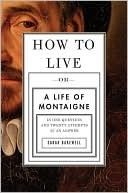The novelist Virginia Woolf imagined people walking past Montaigne’s self-portrait like visitors in a gallery. As each person passes, he or she pauses in front of the picture and leans forward to peer through the patterns of reflection on the glass. “There is always a crowd before that picture, gazing into its depths, seeing their own faces reflected in it, seeing more the longer they look, never being able to say quite what it is they see.” The portrait’s face and their own merge into one. This, for Woolf, was the way people respond to each other in general: As we face each other in omnibuses
...more
Welcome back. Just a moment while we sign you in to your Goodreads account.


